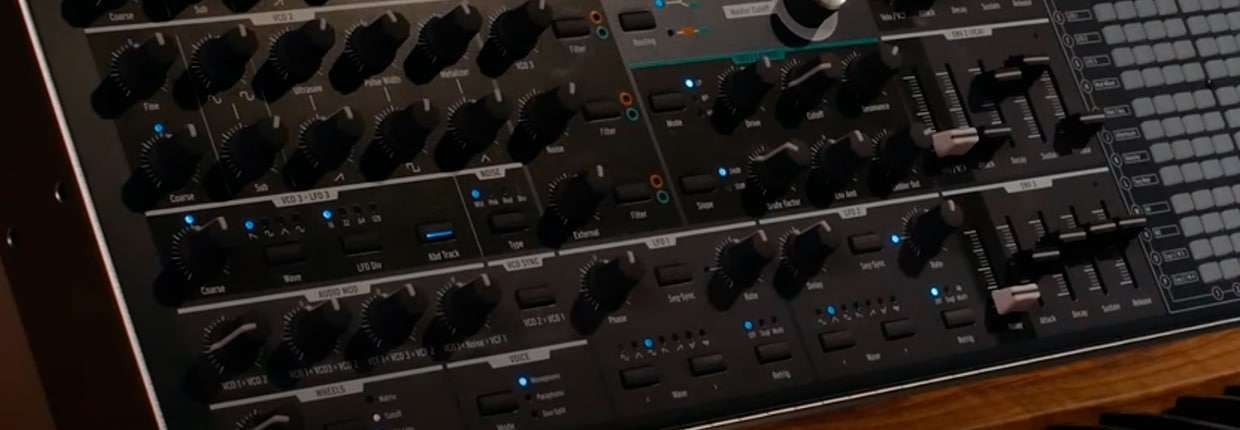Synthese und Synthesizer
Veröffentlicht am 14/06/2022

To track a synthesizer maintaining or improving its sound could be thought as a simple task.
Just connect the synthesizer’s output to the sound card and there you are.
Even if there is nothing wrong with this approach there are a few things that could be relevant to the result.
Let’s give a look.
We have been talking about the systems connection in a specific un post a few months ago. Let’s be more specific by focusing on synthesizers (with just a little math).
They have their outputs at Line level (so at nominal +4 dBu). They can be either mono or stereo, balanced or unbalanced.
A simplified theoretical model is the one in the following picture:

The left side generator (Vg) and its internal impedance (Zg) represent our synth.
The input stage of the following system (let’s stay generic for now) is modeled by the impedance Zi.
The voltage across the input stage (let’s call it Vi) surely depends on the synth output but it is also determined by the impedances values. The relation is (trust me):
Vi = Vg*(Zi/(Zg+Zi))
If you consider that all synthesizers have an output impedance (Zg) and all the receiving systems have an input impedance (Zi) it is easy to understand that there always be a modification to the synth signal whatever will be the system where the synth is connected to.
The difference will be higher as the Zg gets higher versus the Z). The lower is Zg the closer to 1 gets the ratio between the brackets. When this ratio reaches 1 we get (trust me again, but this time it’s easier):
Vi = Vg
Let’s highlight again that this is an ideal condition never verified in the real world.
Things get even more complicated if we consider that:
Wrapping up, all those factors together suggest that a simple connection to the audio interface’s inputs may lead to sensible modifications to the synth signal.
For these reasons, when we are dealing with synth, it is a lot better to consider proper preamps to be part of the game.
The synth tone is generally very complex and with parameters that may considerably vary over the time.
Even a simple monophonic signal can be rich in lows, mids and highs depending on the position of the Cutoff and Resonance controls in the filter.
Those can even be modulated (altering the spectrum) and can derive from oscillators eventually modulated in amplitude or frequency.
The notes can range over the entire keyboard and the combination of sequences and envelope variations can add further changes.
The poliphony multiplies by a factor all this and multi-timbral equipment raises it to a power.
In this case it is better to use preamps with faithfull response to the source and fast response to transients.
To keep the signal’s integrity preamps must have:

If the objective is fidelity it is better to use balanced Line connections.
Preamps falling in this range are Millenia HV-3C, Neumann V-402, e Cranborne Audio Camden 500 (with Mojo bypassed).
The list of clean preamps is way bigger but we wanted here just to give some examples.
Sometimes it can be useful to add something to the timbre should the synth have some weaknesses or just to add a different personality to the track.
In this case we have several alternatives.
The simplest one is to use the high impedance input (HiZ). As stated above if Zi is high things tend to be better.
The nominal impedance of an HiZ stage is 1 MOhm. The Line input has just 10 KOhm. The difference is quite high (HiZ is 100 times the Line).
Also the frequency responses are different so it is always good to give a chance to the HiZ input to try if it is worth using it.
Another way to achieve the goal is to use coloured preamps eventually with input transformers in their I/O stages.
The selection is wide.

ust to name a few we can mention: Tierra Audio Lava preamp, SSL Alpha Channel and API 512v.
Coloured preamps can add harmonics and contribute to the final result of the tracking task. This approach can be useful in several contexts and to eventually better support the artist’s needs.
A further step can be done by using complete channel strips from the consoles or by using rack shaped units.
In this case one can play with the preamp saturation, with the equalizer and with the compressor.
Some months ago we had excellent results to revamp a Korg Minilogue (not being famous for its personality) with the channel strip of the SSL SiX. Even if this is loaded with a clean preamp section, the combo of its equalizer and compressor made a huge difference in picking the best out of the synth’s sequence.

Also in this case the selection is huge, we report just the API The Channel Strip and the Rupert Neve Designs Shelford Channel as ambassadors for the category.
A complex and articulated tone as the one coming out from synthesizers deserves special cares. As for the other instruments, a proper selection of good hardware can make things better.
Do not forget, anyway, the possibility to experiment by yourself. The story says that with synths unusual results have been found with unusual applications. Think about the usage of guitar’s amplifiers to have that special midrange and a huge fuzz box.
Either clean or coloured, recording synthesizers is an exciting challenge given the big amount of options that we can choose from. Why don’t you try by yourself?
Sei dabei und sichere dir 5% Rabatt auf deine nächste Bestellung!

Leerer Wagen